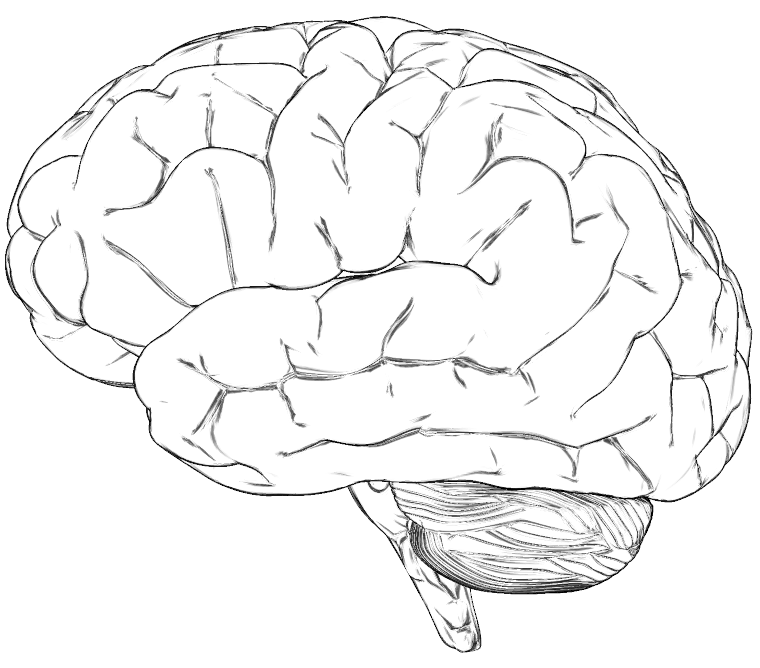
by Jennifer Wolkin | Mar 12, 2018 | Blog, Brain Health, Five to Thrive, Mindfulness, Stress, Wellness
Live your best life: Mindfully control your brain’s reaction to stress
Did you know that the brain’s “stress center,” the amygdala, shrinks post mindfulness practice? In addition, the functional connections between the amygdala and the prefrontal cortex are weakened. This allows for less reactivity to life’s basic stresses, and paves the way for higher order brain functions to be strengthened (i.e. attention, concentration, etc.)

The impact that mindfulness exerts on our brain is borne from routine: a slow, steady, and consistent reckoning of our realities, and the ability to take a step back, become more aware, more accepting, less judgmental, and less reactive. Just as playing the piano over and over again over time strengthens and supports brain networks involved with playing music – mindfulness over time can make the brain, and thus, us, more efficient regulators, with a penchant for pausing to respond to external stimuli instead of mindlessly reacting.
The amazing thing about mindfulness is that you can apply it to any action you engage in on a daily basis; cooking, cleaning, walking to work, talking to a friend, driving – or even drawing or coloring!
Why coloring? Well, for one, we all need to embrace our inner child! As adults, we don’t do enough coloring, or any type of play for that matter. Did you know that play can help reduce stress? Also, believe it or not, coloring utilizes areas of the brain that enhance focus and concentration, and nurturing attention is one of the mechanisms by which mindfulness leads to well-being.
That is helpful, because when we are engaged “on purpose” in a particular task, by focusing on it instead of remaining on autopilot, then our negative and unhelpful thinking seems far away (i.e. isn’t on our minds!) Our minds literally can’t focus on both at the same time.
Yet, it should not be seen as just a distraction from really dealing with our “problems”. By engaging in this exercise, we can continue to deepen our ability to be mindful and train our mind to stay in the present moment rather than habitually straying into unhelpful thoughts about the past or future, to rather stay non-judgmentally present to our every sensation as it unfolds. In this way, we are better equipped to calmly approach our anxiety and parse out if it is a real or imagined stress.
How to practice mindful coloring:
- Start with colored pencils, or crayons or any other drawing/coloring tool that feels right to you.
- Take a moment to notice the feeling of these instruments in your hand. Their weight, texture, the engineering that went into their creation…
- Then, listen to your gut, and start to color without too much thought about it. Don’t analyze your drawing, rather, just let what comes organically come. Try not to edit.
- If you want, you can print multiple pages so you can do this over and over again.
- See if you can focus also on the act of coloring itself as you are engaged in it. Here are some cues for you:
- How does your hand move across the page? You might even want to spend some time following it.
- How do the different strokes look? Notice the difference between using the sharp edge vs. the side of the pencil.
- How do the different colors (if you are using multiple colors) add to the different parts of the image?
- Notice, without judgment, as your drawing unfolds.
What does your unique brain look like?
In my ‘The Grand Conductor’ packet, we go through the biology of the brain, as well as the latest research on how to keep it in tip-top shape, but at the end of the day, it’s important to remember that we’re just brains studying brains. We’re limited in our understanding of the brain by the virtue of the very thing we’re using to study it!
In addition, just as every individual is unique, so is each brain different from the next, and, moreover, constantly changing as we age! So, let’s all open our minds (see what I did there?) and learn more about ours, and each other’s, unique brains.
Print out the brain image below and color it in however you please! Remember to try to practice staying mindful during the process. Let it reflect the latest brain science (learn more from the infographics at the bottom of this blog!) or let it reflect your own personal understanding of self. Whatever you decide – Let your mind soar! Keep in mind, it’s not about being an artist, in fact, no artistic skill is necessary. Just dive in and notice, again, without judgment, what the process is like for you. I’m going to do this as well, and share it on my social media pages, so stay tuned!

When you are finished, please, #ShareYourBrain on social media and tag @BrainCurves!
BRAIN EVOLUTION, ANATOMY & PHYSIOLOGY, AND WELLNESS INFOGRAPHICS
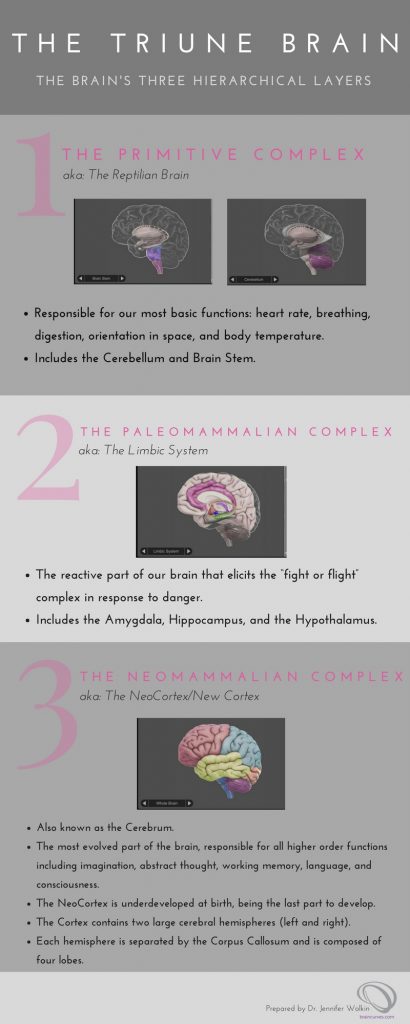
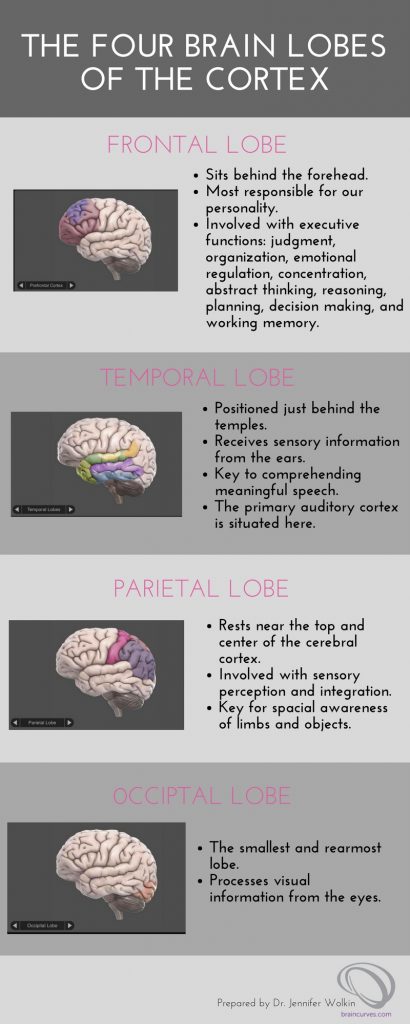
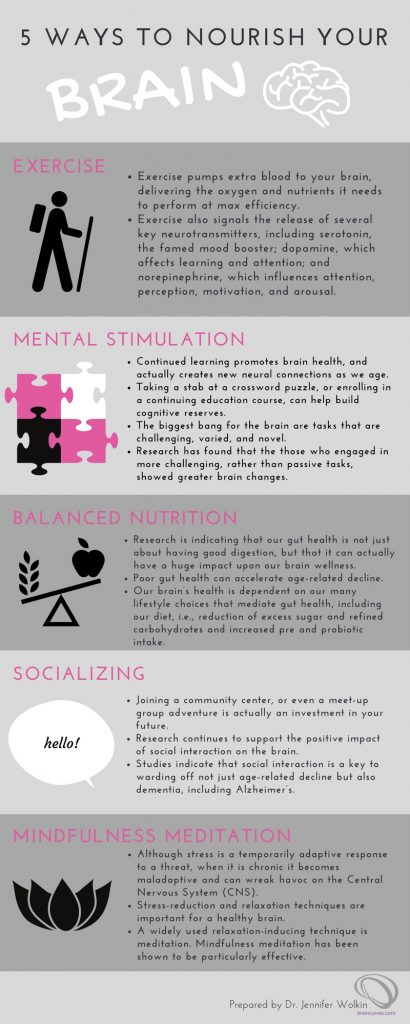
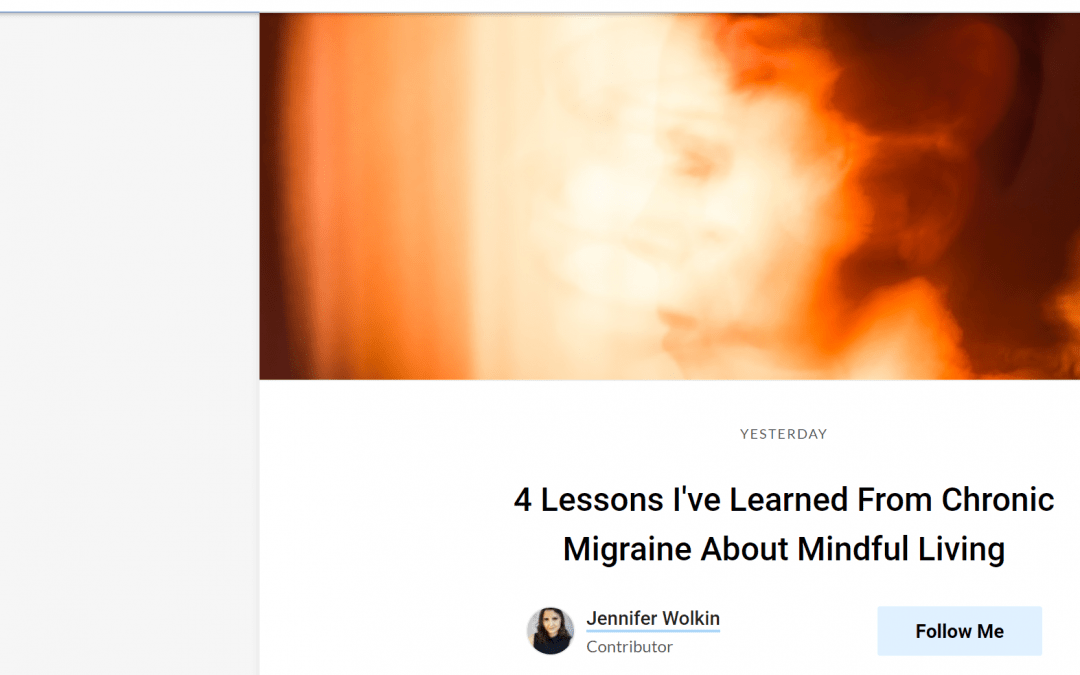
by Jennifer Wolkin | Feb 12, 2018 | Blog, Brain Health, Mindfulness, Wellness
This post originally appeared on The Mighty. The blog below has been updated since the original post.
I’ve had episodic migraines all my life. My doctor categorized them as “menstrual migraines” because a day or two before menstruation a bad headache would strike, sometimes with nausea, and mostly on one side of my head.
I’d take four Advil, put an ice pack on my neck, and be fine a few hours later. It seemed like a given, and I just went with it. Looking back, I found them routine, rather than debilitating.
That all changed a few years ago; here’s how I remember it:
In June 2017 I took a flight from New York City to the West Coast, and then two more flights within the same week. I experienced 110° F Las Vegas summer weather, jet lag, and overall exhaustion. I was still feeling stressed from the news the month prior that I might be experiencing perimenopausal hormonal changes (read: premature ovarian insufficiency). Then, on the fourth day of the trip, after sleeping for 16 hours straight, I woke up feeling an off-ness that grew into a slew of neurological symptoms that never went away.
This perfect storm of events, as my neurologist called it, must have set off a cascade inside my body that culminated in a migraine that has lasted for the past two years in varying degrees of intensity. I have had various in and out symptoms including light sensitivity, dizziness, nausea, blurriness, stabbing eye pain, gastric stasis, brain fog, and headaches.
Some might call it status migrainosus, which by definition is a migraine that lasts for more than 72 hours. Whatever we call it, my migraines clearly went from being episodic to a chronic and debilitating issue. The initial migraine technically broke two months later following a steroid taper, which gave me two days of relief. Since then, I have had on and off symptoms almost daily in varying degrees and intensities.
Despite the pain and discomfort, this time has been ripe with lessons in more mindful living. Going through this experience has been a game-changer in the level of care I provide to my own clients who experience migraine. I can relate on a level that immediately sets me a part from other health psychologists.
Here are some of the things that I’ve learned:
1. Awareness
Knowing and eliminating my triggers:
While migraine is often genetic, and there is no one agreed upon cause, there are triggers involved – which don’t cause an attack, but can set one off. Some are uncontrollable, like barometric pressure, and some can be managed through lifestyle changes. The latter requires meticulous self-calibration.
I’ve eliminated many dietary triggers, including alcohol, chocolate, anything with tyramine, anything with nitrates, and even some food high in histamines. The calibration continues, as even the amount of caffeine that I put in my body can put me at risk for symptoms. So, every morning I have just the right amount of espresso, no more, no less. This also applies to sleep. I need enough sleep to feel well, but too much sleep can actually tip the scales in the wrong direction. This awareness to detail has been a bit painstaking, and it sometimes feels like a roulette game. Yet, I’ve never been so aware of what my body needs in any given moment.
Recognizing the subtle signs of a migraine before they escalate:
My interoceptive awareness has been heightened in a beneficial way. Some of the medications to abort migraine work best when you can catch the symptoms early. This has required me to be consciously aware of the subtle nuances in the way I feel at any given moment. Of course, at its extreme, this can become almost obsessive. But when it’s for the sake of one’s wellness, it feels calming to be able to know that I can help myself by being more attuned to my body.
For me, my heart starts to race, my vision tends to blur, and my shoulders and neck start to tighten. I’ve learned that by noticing these symptoms early, I can sometimes even skip the medication by immediately applying peppermint oil to my wrists and temples, ice on my forehead, and heat on my neck area.
2. Self-Compassion
Less “shoulding” all over myself:
I have a tendency to “should” all over myself to the tune of, “I should be writing my book right now, I should be creating my e-courses, and I should expand my practice to include group therapy, etc.” At times, however, the symptoms were so disabling that I couldn’t do much but lay in a dark room. In those moments, I worked hard on letting go of my “shoulds, ” such as, “How can I be laying here when I should be accomplishing this and that and the other thing?!”
Compassion for my body:
Chronic migraine forced me to take a break from physical exertion. With the lack of consistent cardio, coupled with the weight-gain side effects of certain medications, I saw the number on the scale go up. At first, I started to obsess over the weight that I “should” be at. Then, I started to have compassion for the strength of my body as it went through this process. Instead of focusing on pounds, I focused on wellness.
I am finally challenging many of the “shoulds” I’ve amassed, and as I do I notice the seeds of self-compassion budding within me.
3. Gratitude
Gratitude for moments of relief:
I’m certainly not going to imply that we have to struggle in some capacity to feel and express gratitude! Yet, the caliber of gratitude that I felt in the moments when I experienced even modicums of relief from my migraine symptoms, was something I’d never experienced in all my years of gratitude training. I found myself literally saying, “Thank you, thank you, thank you!” But when the pain returned, and I was at risk for falling into a darkness, “Why was that relief taken away from me!?” I challenged that thought, and reminded myself that if I had a moment of relief, I would have another – and that gave me hope.
Gratitude for the care I have been, and continue to be, shown:
I tend to be more of a nurturer, caregiver type — much better at giving than receiving — but because of the sometimes disabling nature of migraine, I literally had no choice but to allow myself to surrender to others’ giving.
Whether it was foot massages in the throes of a more severe attack, ice and heat around the clock as needed, mailing me different essential oils, including peppermint — which I’ve found has been crucial — showing up to the ER when the relentless pain called for a visit, calling or checking in daily, helping me strategize to find the best and highest caliber treatment team, and even just holding me during some of the more emotional moments when I’d cry from exhaustion, when the hope was too hard to hold, when I couldn’t see my future.
To see those I love show up in many different ways to bring me even just a little more relief filled me with gratitude — again, the kind I had never quite felt before.
4. Patience
Patience in finding the right treatment:
By nature, I tend towards the more impatient end of the spectrum. I like to take productive action and see immediate results — cause and effect, right? Well, sometimes, life just doesn’t work like this and I have had to maintain patience across many facets of my migraine experience.
Finding the right treatment team takes time. Not every doctor is going to be the right fit for your needs, and that’s OK. However, it can feel like a job finding the point person who will facilitate the appropriate treatment, the clinician who is the right fit. After a few months, thanks to a friend’s recommendation, I’ve finally found someone.
Often, treating migraine also calls for finding the right cocktail of medications. This takes a lot of time, too. Not only do you need to find the right combination that works for each unique individual, but it also takes at least one month before you’ve given each and every medication its “fair shot.” Plus, some come with egregious side effects, and you have to decide: do you wait it out and hope they subside as the medication takes effect – or do you stop it, and start over?
I’d like the healing to be more linear and more blatant, but it’s not. There’s a lot of waiting involved, and the waiting feels compounded because it happens sometimes in the context of great discomfort and pain. Baby steps is my new mantra, but none of this feels easy.
So, while it’s taken a solid treatment team, preventative meds, significant lifestyle and dietary changes, and incredible support, I have no doubt that these lessons are part of my healing process.
That’s the irony of all ironies. The lessons learned are like lifeboats in an unpredictable, roaring sea. Again, one doesn’t have to struggle to “see the light,” but if one is experiencing discomfort and pain, there’s more to see in that muck than meets the eye.

by Jennifer Wolkin | Apr 23, 2017 | Blog, Five to Thrive, Mindfulness, Relationships, Stress, Wellness
This blog post originally appeared on Mindful.org
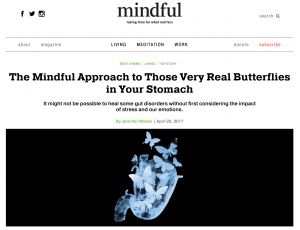
An Early Account
In the 1950’s Dr. Thomas Almy, a prestigious gastroenterologist, snapped a picture of a live colon responding to the proverbial “butterflies in the stomach.”
Dr. Almy invited a student to take part in an experiment where he used a sigmoidoscope to look inside the student’s rectum and colon. A bystander complicit in the experiment said something about cancer of the colon. Upon hearing this, the student concluded that he must have cancer, at which time his colon started to change color, tense up, and contract rapidly. When the student was reassured that cancer was not his diagnosis, his colon regained its natural color, and relaxed.
This experiment paved the way for a deeper understanding of the visceral processes behind our gut-wrenching experiences. Getting butterflies before a big test or nausea right after a breakup: those feelings are much more than anecdotal. It’s a physiological reality that our emotions and stress physically impact our gut.
The Brain-Gut Axis and Stress
One of the major breakthroughs in understanding how the central nervous system (CNS) and the gut communicate was the discovery of the enteric nervous system (ENS). The ENS, sometimes called the “second brain,” is a complex system of about 100 million nerves found in the lining of the gut. Both of our brains, so to speak, are in constant dialogue and speak in many “languages” as they send signals to and fro via neural and endocrine pathways that collectively have been dubbed the “Brain-Gut Axis” (BGA).
The BGA plays a prominent role in our overall wellness, and there is significant evidence that it’s susceptible to stress. The route to BGA dysregulation has many avenues, all of which make the gut more vulnerable to disease.
Stress-induced changes in the physiological functions of the gut include changes in: gut motility, mucosal permeability, visceral sensitivity, gastric secretion, and the gut microbiota. Changes to gut microbiota is called dysbiosis, which may lead to disease. Many of these stress-induced changes account for the symptoms seen in many gastrointestinal disorders.
Functional Gastrointestinal Disorders (FGIDs): When the Gut Acts Up
In my clinical practice, evidence of the BGA is most visible in the functional gastrointestinal disorders (FGIDs): cases when the gut is acting up and there’s no obvious physical cause, like a tumor or bowel obstruction, for example. This does not mean that an FGID is all in one’s head, however. A more precise conceptualization is that stress influences the actual physiology of the gut. In other words, psychological factors can impact upon physical factors, like the movement and contractions of the GI tract, causing inflammation, pain, and other bowel symptoms. These disorders often significantly reduce quality of life.
FGIDs include the better-known irritable bowel syndrome (IBS) and the lesser-known small intestinal bacterial overgrowth (SIBO). Given their functional nature, they continue to be difficult to treat, and often require GI doctors to use multiple treatment modalities and make referrals to other clinicians, including psychologists.
A Vicious Cycle
To be clear, the brain-gut connection is complex. For one, it is bidirectional; just like a stressed brain sends signals to the gut, a troubled gut sends signals to the brain, putting someone at greater risk for anxiety and other neuropsychiatric difficulties. Parsing which came first, the stress or the gut distress, becomes challenging and most often this bidirectionality between enteric and central nervous systems is a vicious cycle of great discomfort.
Just like a stressed brain sends signals to the gut, a troubled gut sends signals to the brain, putting someone at greater risk for anxiety and other neuropsychiatric difficulties.
On top of that, many of the FGIDs become chronic conditions, which pose a stressful physical and psychological burden. Many of the patients I treat come see me because having a disorder like IBS primes them for stress that maintains the original symptoms. For example, while stress is a clear player in the origin of FGIDs, “gut-focused” thoughts, emotions, and behaviors start to create stress that reinforces the underlying pathophysiology (i.e., slows motility, visceral pain). For example, my patients with FGID have become hyper-vigilant of their heightened visceral pain and then begin to catastrophically appraise their abdominal sensations. Also, their quality of life starts to significantly decrease, many times leading to anxiety and depression.
Many of the patients I treat come see me because having a disorder like IBS primes them for stress that reinforces the original symptoms.
A SIBO Story
I’ve learned about the FGIDs firsthand. I have a deeply personal connection to the BGA, and it serves to enhance my professional passion and expertise on the subject. In the winter of 2013, I experienced a feeling of pressure in my stomach after every meal. I felt visceral pain, and it felt difficult to empty my bowels. My heart felt fiery. I wasn’t just bloated—I looked pregnant. I had a belly the size of six-month gestational equivalence.
I wasn’t just bloated—I looked pregnant. I had a belly the size of six-month gestational equivalence.
I was otherwise healthy, and thankfully so, and the onset of symptoms was anxiety provoking. After a multitude of tests ruled-out anything life threatening, I took a hydrogen breath test that my GI specialist said was indicative of small intestinal bacterial overgrowth (SIBO).
I had never heard of it before, so I began to just refer to myself as a “digestive mess.” It definitely felt like a mess, as SIBO had nonchalantly decided to go camping in my gut, like a pesky parasite sucking the life out of every ounce of normal flora to be found. Camping: as in pitching tents, starting fires, and sleeping in the dark hollows of my alimentary organs (i.e., my gastrointestinal tract).
This was my up close and personal reckoning with just how much stress was taking over my mind—and body. SIBO was a wake-up call to inspect my habitual patterns of thinking and behaving that were adding to my stress levels over time.
This was my up close and personal reckoning with just how much stress was taking over my mind—and body. SIBO was a wake-up call to inspect my habitual patterns of thinking and behaving that were adding to my stress levels over time. These patterns weren’t “bad” per se, they were just not serving my wellness. It is hard to pinpoint any one stressor, or any one pattern that contributed to SIBO. In retrospect, it was probably an accumulation of stress that I carried with me during a grueling postdoc. Postdoc was an extraordinary experience that afforded me first-class training. Yet, I pushed myself without taking the time to rest. I can still recall one of my supervisors saying that “postdocs” never get sick, or if they do, they sweat through it, and suck it up. All I could think then if I needed a break was “I am such a failure.” I think I carried this line of thinking with me as I embarked on the first phase of my career post-training. I kept going without rest, and if I needed a break I’d once again hear the stress-inducing voice in my head reminding me of what I thought was my inadequacy.
It is hard to pinpoint any one stressor, or any one pattern that contributed to SIBO. In retrospect, it was probably an accumulation of stress that I carried with me during a grueling postdoc. Postdoc was an extraordinary experience that afforded me first-class training. Yet, I pushed myself without taking the time to rest. I can still recall one of my supervisors saying that “postdocs” never get sick, or if they do, they sweat through it, and suck it up. All I could think then if I needed a break was “I am such a failure.”
SIBO was a wake-up call, albeit a very uncomfortable one. So uncomfortable that I began to resent my body, avoiding social engagements, and hyper-focusing on my symptoms. The heaviness I physiologically felt in my core became a psychological burden, and I became depressed, until I finally realized that by calling myself a “digestive mess” I was colluding in the maintenance of my pain.
4 Ways to Treat FGIDs Using the Mind
Since multiple components, including physiological, affective, cognitive, and behavioral factors are associated with FGIDs, an integrative approach to treatment is prudent. The research indicates that psychological interventions have been successfully applied. More specifically, a large number of randomized controlled trials suggest that cognitive behavioral therapy (CBT), biofeedback, relaxation techniques, and mindfulness meditation are effective psychological interventions for FGIDs.
1) Cognitive Behavioral Therapy
Cognitive Behavioral Therapy is based on the idea that sometimes people engage in habitual thinking patterns that are founded on a skewed perception of their experiences or unhelpful, “distorted” thinking. It’s an inquiry-based approach that asks people to take notice of their mood changes and the habitual patterns of behavior they engage in.
CBT is the most studied psychological intervention vis-à-vis FGIDs, and most studies were conducted with IBS populations. Many people with IBS engage in unhelpful thinking styles related to their actual symptoms, which then impact upon their moods and behaviors. For example, imagine a scenario during which someone with IBS is certain that eating out in public means they will absolutely have diarrhea. The thought creates anxiety, which might actually lead to autonomic arousal that could potentially trigger diarrhea. Eating out is now linked to having diarrhea and so eating out is likely avoided. CBT treatment would first be geared toward helping someone identify this pattern of thinking, feeling, and behaving. Then it would be utilized to help someone learn to challenge this unhelpful thinking and develop healthy active coping skills.
One study conducted over twenty years ago focused on the impact of CBT on IBS by randomizing 34 patients to eight weeks of cognitive therapy, a self-help support group, or a waitlist control. The results indicated that post-treatment the cognitive therapy group showed a significant reduction in gastrointestinal symptoms, as well as significant improvement on measures of depression and anxiety when compared to both the support group and waitlist control paradigms. These results were maintained at a three-month follow up.
A recent study, published in January 2017, looked at the effects of a 12-week course of face-to-face CBT on 18 subjects with IBS. Results indicated a decrease in self-rated visceral sensitivity, as well as associated psychiatric symptoms. The authors of the study attributed the results to increased ability to cope with IBS symptoms.
2) Relaxation Techniques
In 1975, Herbert Benson, a physician at Harvard, introduced the concept of the relaxation response. It is the physiological opposite to the fight or flight response. In this way, stress management can be achieved by dampening the effects of the sympathetic nervous system’s “fight or flight” arousal mechanisms by activating our parasympathetic nervous system through relaxation techniques.
Research has suggested that practices like meditation, yoga, and prayer, which elicit the relaxation response, alleviate stress and anxiety’s physiological counterparts, which as we now know, can impact gut motility and induce dysbiosis.
A pilot study from Harvard University affiliates Benson-Henry Institute for Mind Body Medicine at Massachusetts General Hospital and Beth Israel Deaconess Medical Center was designed to investigate whether meditation, a relaxation-response-based intervention could reduce negative symptoms and improve quality of life in patients with IBS and irritable bowel disease (IBD). Forty-eight patients with either IBS or irritable bowel disease (IBD) took a 9-week session that included meditation training, and the results showed reduced pain, improved symptoms, stress reduction, and the change in expression of genes that contribute to inflammation.
3) Biofeedback
Biofeedback uses computerized technology to help someone learn to control or manage the body’s response to stress. Sensitive instruments are used to measure physiological processes, like heart rate variability and/or muscle contractions, for example, with the purpose of “feeding back” the information to someone so they can learn to control them.
In terms of FGIDs, biofeedback’s effectiveness has mostly been investigated in those experiencing functional constipation. In this case, biofeedback is used to help someone tune in to a propensity for paradoxically contracting the pelvic floor muscles during bowel movement (often referred to as pelvic floor dyssynergia (PFD), and then to train someone to relax these muscles instead.
One study compared the effects of five weekly biofeedback sessions with those of laxatives plus counseling in patients with severe PFD. The researchers studied overall satisfaction with treatment, symptoms of constipation, and pelvic floor physiology. At six months, improvement was reported in 80% of patients in the biofeedback group vs. 22 % in the other group. Results were sustained at 12 and 24 months post-treatment. More specifically, biofeedback produced a greater reduction in straining, a greater reduction in the sensation of incomplete evacuation, a greater reduction in abdominal pain, and reduced use of suppositories. Since the study clearly indicates the benefits of five biofeedback sessions vs. continuous laxative use, it’s become the gold standard for treatment for this type of functional constipation.
4) Mindfulness Meditation
John Kabat-Zinn, the pioneer of mindfulness meditation’s use in Western psychological interventions, proposes that mindfulness is a state of greater awareness cultivated by paying attention on purpose, in the present moment, and without judgment. This definition reflects mindfulness’ positive impact upon sensory, cognitive, and emotional processing through cultivating purposeful, present-moment focus on experiences without the added judgment and evaluation often projected onto them. Since FGIDs are often maintained by the stress burden induced by the narrative that is created about the symptoms—a narrative that is rooted in judgment—mindfulness meditation has recently been studied and added to a growing list of possible psychological interventions for FGIDs.
One particular study in the Journal of Behavioral Medicine, looked at the impact of mindfulness training based on the MBSR program developed by Kabat-Zinn, on the quality of life of 39 women with IBS. As compared to a control group, the women who received the training experienced a significant attenuation of symptoms and an increase in quality of life.
More specifically, the mindfulness training cultivated a less reactive mindset toward potentially distressing thoughts, emotions, and sensory experiences. As the women were able to just witness their visceral sensations without catastrophically appraising them, anxiety was reduced, pain was attenuated, and they even started to think they had the potential to successfully cope with their symptoms.
Mindfulness for My SIBO Case
I personally looked toward mindfulness meditation to help me sit through a lot of the discomfort from SIBO. I repeatedly practiced sitting with the sensory experience of my symptoms without the added judgment. The anger toward my body for betraying me was slowly replaced with a compassion for what it was enduring.
The anger toward my body for betraying me was slowly replaced with a compassion for what it was enduring.
Overall, what I learned through my healing process, in a nutshell, is that given just how clear it is that emotional and psychosocial factors can trigger symptoms in the gut, I needed to make some lifestyle changes. So I did, and I still do. When we have engaged with certain unhealthy thoughts, feelings, and behaviors for a long time, the path toward wellness takes extra patience, perseverance, time, and trust. Nothing about the path is easy. Sometimes, it’s even disheartening. Always, it’s worth the chance to thrive.

by Jennifer Wolkin | Dec 8, 2016 | Blog, Five to Thrive, Mindfulness, Relationships, Stress, Wellness
This blog post originally appeared on Mindful.org
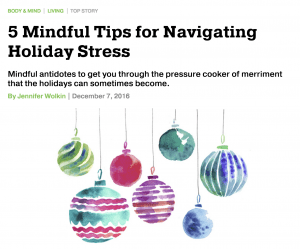
It is officially the holiday season! During this time of year there can be so much pressure that unfortunately the joy, magic, and meaning of the season is lost, often replaced by stress. Especially now that Thanksgiving has come and gone, it is hard to ignore the almost instantaneous rush of frenetic energy that ensues as we near the close of the calendar year.
It is more than possible though to not only survive the holiday season, but to even thrive and connect to your particular observance in a deeper and more profound way. Here are some common stressors that pop up this time this year, and mindful antidotes to help you through the discomfort.
1) Demands on Time
In December, our schedules often fill up quickly with work and personal holiday parties. These back-to-back parties start to feel overwhelming as we try to juggle them with all of our other commitments.
Also, creating the holiday experience we desire for our loved ones and ourselves takes planning. It often starts to feel like we are chickens running around with no heads collecting recipes, buying and wrapping gifts, inviting guests, hosting, traveling, cooking, cleaning, buying trees (or menorahs!), and decorating.
Antidote: Treat yourself!
You do not need to say yes to everything. Giving and giving without stopping is not an altruistic notion. It is important to be mindful of when we might need refueling and to allow that to happen. Self-care can mean many things, but it can be as simple as a night to ourselves that includes a bath and a good meal—cooked by someone else!
2) Loneliness During the Holidays
There is an immense amount of pressure to please the people we love with the gifts that we think they will love. Instead of a joyful endeavor, gift giving becomes a chore, and we often become resentful and unloved if we do not receive something equally meaningful in return.
Pressure can also manifest by way of the longing to spend the holidays with those we love, and those we desire to love. For many, this may create feelings of loneliness.
Antidote: Donate your time to help those less fortunate.
The holidays are a particularly poignant time to practice the art of compassion, to think of others needs before our own. There is great opportunity to give to, and establish meaningful connections with, those who don’t have as many resources as we do. Giving doesn’t have to be monetary or a physical gift. Giving comes in many forms, including smiles, time, and emotional support.
3) Expectations of Perfection
This time of year is ripe with the expectations we put upon ourselves to get it just “right.” Things have to look, taste, feel, and be a certain way. We start to get into this mind space where things have to be perfect, which of course, is not possible. It’s how we deal with this realization that determines our well-being.
While it is nice to take the time to create a mindful, aesthetically, and gustatorily pleasing experience, we often get caught up in the trap of perfection. Not only does this make the holiday journey feel less joyful, but we also set ourselves up to experience a lot of disappointment.
Antidote: Reflect on the meaning of the holidays.
It is hard to stop and smell the roses at any time of year, and it is especially easy to get caught up in the commercial version of what the holiday season means today. But taking the time to mindfully reflect on what matters, whether it be our religion or tradition, or even the healing power of love, helps us to keep our perspective as the year draws to a close.
4) The Indulge/Guilt Cycle
We often seem to let all notions of wellness and health fall by the wayside during this time of year. The problem is not only are we not staying healthy, but we are also setting ourselves up for feelings of guilt and self-deprecation.
A thriving life depends on moderation, and this concept particularly applies when we are inundated with mass amounts of food and drink. By eating mindfully, we can keep our minds, bodies, and brains healthy without the self-defeating thoughts of “we are so bad” “we are so fat,” etc.
Antidote: Take time to enjoy all the flavors of the holiday season.
There are five (A,B,C,D,E) basic ways to begin a mindful eating practice:
1. Ask
- Why am I eating now?
- What am I eating now?
- What else am I doing now that may be distracting?
2. Be grateful
3. Chew, and then chew again
4. Dine (don’t just eat)
5. Engage your attention
5) Stress: Family Anxiety
Family stress shows up in many ways. This has taken on a new tone this year, given that many families made different political choices.
While there might actually be very real difficulties surrounding the interpersonal dynamics of our family, we sometimes get caught up in fuelling the fire, rather than abating it.
However, most of the stress and anxiety around family is often anticipatory. Based on not-so-pleasant past experiences, combined with the upcoming impending mix of different personalities, we start to worry about family dysfunction rearing its ugly head. While there might actually be very real difficulties surrounding the interpersonal dynamics of our family, we sometimes get caught up in fuelling the fire, rather than abating it.
Antidote: Engage in gratitude.
Take the time to step back and bear witness to all that you have, to count your blessings, as they say. Gratitude goes a long way when it comes to overall wellness. During this time of year, a sense of gratitude can easily fall by the wayside as indulgence and the idea of “more” and “merrier” are front and center.
So, while in the midst of the tumult of the holiday season, try to re-center by consciously being grateful for the multiple aspects of this season, and our loved ones, that we are blessed to engage with.

by Jennifer Wolkin | Oct 2, 2016 | Blog, Mindfulness, Wellness
This blog post originally appeared on YogaCity.

Trying to write my dissertation jolted me into a realm of self-blame and self-criticism. I procrastinated because it was a burden, a dragon whose fiery mouth I wanted to avoid at all cost. I was anxious and I struggled with that internal voice of doubt that whispered, “are you sure you are good enough for this?”
Early on, immersing myself didn’t feel good. I definitely did not expect it to be easy. Nothing worth doing gets done without hard work ever is – but I certainly couldn’t have predicted the negative energy that I allowed the dissertation to create.
So I avoided it in an attempt to make all the negativity disappear. Of course, the more I avoided it, the bigger it became.
Then I began to devote myself to a modest practice of yoga to find more tranquility, focus, and calm. At first it was nearly impossible. My mind raced with thoughts: thoughts of fear, uncertainty, worthlessness, inability to succeed, and even thoughts about thoughts.
My initial poses were haphazard, pretzel-like and ungraceful. My breath pattern was quick and shallow, reflecting my difficulty holding the asanas as my mind strayed in all directions. “At least,” I kept telling myself, “I was coming to the mat.”
As long as I carved out my space, a little rectangular niche of my neon green rubber yoga mat, I was going to be okay. By the time savasana approached I could at least surrender my self-deprecating thoughts to some indescribable energy created by the convergent effects of movement and breath.
Yoga gave me perspective, which I craved, and I began to practice up to four days a week. Soon, the natural progression of my day became a yoga practice and then hours of writing. The energy generated through yoga was evident in the organization of my thought and ability for my thought to be transferred coherently into words. To do yoga and then write was a logical pattern I fell into.
Ultimately, I chose to bring my journey both off the mat, and out from behind my computer. I let go of the striving to finish it, and the attitude of just “needing to get this done and over with.” Slowly but steadily learned to reinforce the small steps, as I remembered my practice and the way my once quick and shallow breath slowed down and became more melodic, deep, and visceral, to the little baby steps I made with my balance until my physical core and my spiritual core became stronger.
In this way, the yoga was an organic foray into learning about mindfulness and how to engage any process through a more mindful lens. As I cultivated my ability to focus on the breath as I moved in and out of asana, my mind wandered less; instead, I became present to the moment as it was unfolding. Being present, it turned out, was more enjoyable and fulfilling than remaining on autopilot, and, at the whim of my wandering mind. With the same practice off the mat, the dissertation no longer became something I just did, but became a journey, which I appreciated and sometimes even savored, at every stage.
Yoga practice fostered a lens by which I could see my dissertation as a metaphor for living life in general. That is, as Jon Kabat-Zinn says, “on purpose.”
In the end, neither yoga nor mindfulness will eliminate life’s pressures. Yet, take it from me: embracing life as a journey of poignant moments to be lived fully over the course of a lifetime makes me feel like I’m thriving.












